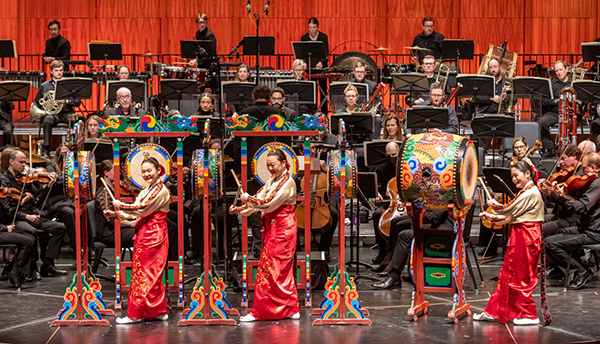by Peter Feher

The program’s second half stayed strictly musical, with a straightforward reading of Sergei Rachmaninoff’s Symphonic Dances. Any movement that took shape came directly from the score, in the rhythms and accents the composer used to virtuosic effect in his writing for orchestra.
Music director Christopher Wilkins let these gestures speak for themselves Saturday. He had the first movement, “Non allegro,” ticking along, rarely dwelling on transitions or single phrases. The second-movement waltz received a similar, straight delivery but eventually found some flexibility in its accelerando rush to the end. The Akron Symphony players kept up the energy in the finale, carrying off their parts with the exaggeration that’s key to getting the music off the page and moving with a life of its own.

Composer Kyle Newmaster accomplished something along the lines of translation with his score. Rhythms that begin in the percussion section are handed off to the soloists at the front of the ensemble, each positioned at a hanging drum setup. Choreographed by Brooke Jee-in Newmaster — who also performed one of the solo parts, along with Holly Shin-young Knudson and Quinn Lee — the piece is equal parts visual and musical, as the drummers jump, rotate, and bend over backwards, all while keeping up a steady percussive line.
Poise and balance were the virtues here, and they held for Turina’s Danzas fantásticas. Choreographer Brian Murphy set the piece’s outer movements as a ballet inflected with some of the music’s Spanish flair. A different female partner joined him for each dance — Christina Lindhout and Morgan Walker in contrasting red and black dresses — adding narrative intrigue to a naturally alluring score.

Anna Clyne’s Masquerade also finds inspiration in folk material, in this case a 17th-century English dance tune. Snippets of melody emerge amid swarms of notes in the strings. The effect keeps you off-kilter — music that’s stimulating but that you certainly couldn’t dance to.
Photos by Dale Dong.
Published on ClevelandClassical.com April 6, 2022.
Click here for a printable copy of this article

